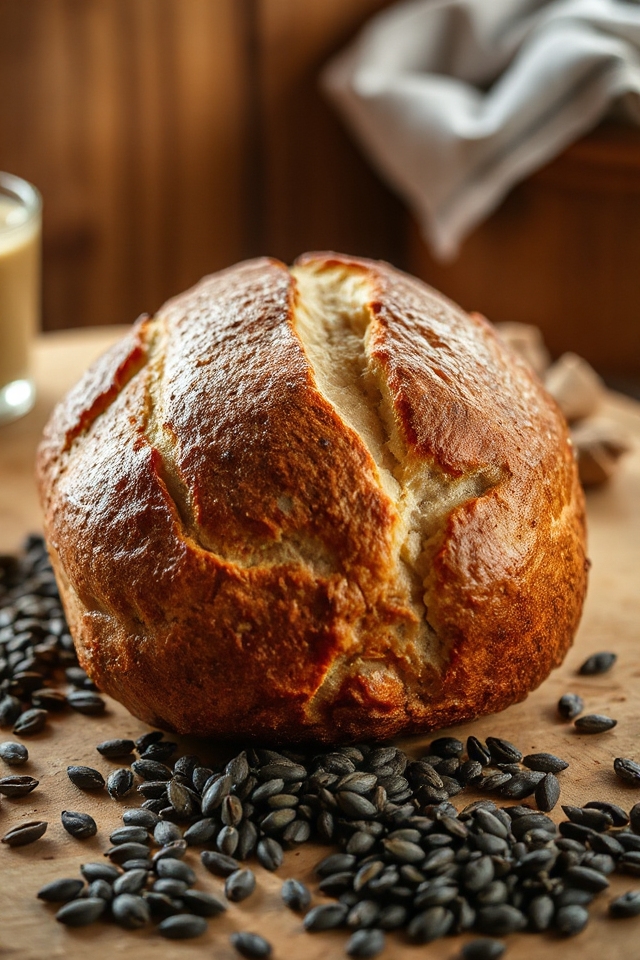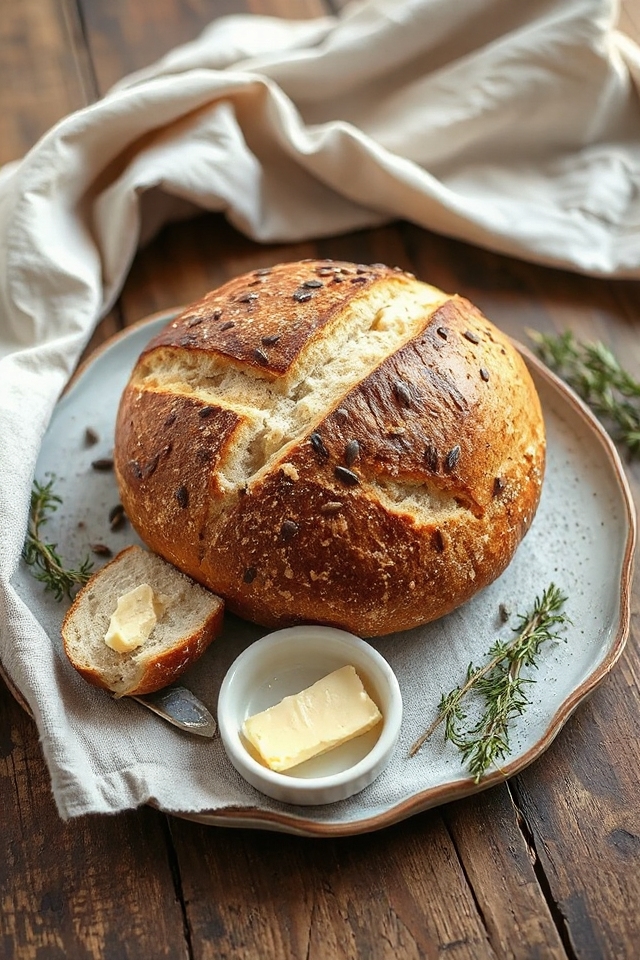Why You’ll Love This Crusty Sourdough Rye Bread Recipe
If you’re looking for a bread that’s both flavorful and satisfying, you’ll love this crusty sourdough rye bread recipe. The combination of tangy sourdough and earthy rye creates an irresistible flavor that’s perfect for any meal.
I can’t get enough of the crust—it’s crunchy and golden brown, giving way to a soft, chewy interior. Plus, the aroma that fills my kitchen while it bakes is simply heavenly.
With each slice, I enjoy the nutty notes of the rye and the hint of caraway seeds. Trust me, once you try this bread, you’ll want to make it again and again!
Ingredients of Crusty Sourdough Rye Bread
When it comes to making crusty sourdough rye bread, having the right ingredients is key. You’ll need a few staples that might already be hanging out in your pantry, along with some special items to really make that flavor pop.
Don’t worry if you’re not a baking whiz; this recipe is more about enjoying the process than being perfect. So, grab your apron and let’s plunge into what you’ll need to create this delicious bread.
Ingredients:
- 1 cup sourdough starter (make sure it’s at room temperature)
- 1 1/2 cups rye flour
- 1 1/4 cups warm water
- 1 (2 1/4 teaspoon) packet active dry yeast
- 1 cup whole wheat flour
- 1 3/4 cups all-purpose flour, plus an additional 1/2 cup for adjustments
- 1 teaspoon salt
- 1 tablespoon sugar
- 2 1/2 tablespoons caraway seeds
Now, a little note about the ingredients: your sourdough starter is like the superstar of this recipe. It’s what gives the bread that lovely tangy flavor, so make sure it’s bubbly and ready to go.
If you want to really amp up that sour taste, you can let the starter and rye flour mixture sit for a while before adding the yeast. It’s kind of like letting a fine wine breathe—trust me, it makes a difference.
Also, don’t be shy with the caraway seeds; they add a unique touch that elevates the bread from good to absolutely crave-worthy.
And if you happen to have any leftover rye flour or caraway seeds hanging around after you bake, well, that just means you have an excuse to make this bread again soon.
Happy baking!
How to Make Crusty Sourdough Rye Bread

Alright, let’s roll up our sleeves and plunge into the art of making crusty sourdough rye bread. First things first, grab that 1 cup of sourdough starter from your countertop. If it’s bubbling away like a happy little potion, that’s a great sign.
Combine that starter with 1 1/2 cups of rye flour and 1 cup of warm water in a large bowl. Give it a good stir to blend everything together. Now, if you’re feeling adventurous and want that extra tangy kick, cover the mixture with plastic wrap and let it sit in a warm place for anywhere between 6 to 24 hours. I usually let mine chill for about six hours, and trust me, it fills your kitchen with the most inviting aroma.
Once you’re ready to move on, take a small bowl and mix 1 (2 1/4 teaspoon) packet of active dry yeast with the remaining 1/4 cup of warm water. Let it sit for about 5 minutes until it gets all foamy and excited—like it’s ready to party.
Stir this bubbly mix into your sourdough mixture, then add in 1 cup of whole wheat flour, 1 3/4 cups of all-purpose flour, 1 teaspoon of salt, 1 tablespoon of sugar, and 2 1/2 tablespoons of caraway seeds. Now, if you’re like me and have a love-hate relationship with sticky dough, you’ll want to mix it until it comes together. I usually opt for my trusty KitchenAid on low speed for this part.
Once it’s combined, knead the dough for about 9-10 minutes on a slightly higher speed until it feels smooth and springy. If it’s too sticky for your liking, you can sprinkle in a tablespoon or two of all-purpose flour as you knead.
After all that hard work, cover the dough and let it rise in a warm spot for about 1 to 1.5 hours, or until it doubles in size. This is the time when you can take a well-deserved break or ponder your life choices—like why you decided to bake bread from scratch.
When your dough has risen beautifully, punch it down to release some air—don’t worry, it’s not a crime, just a necessary step. Shape it into a round loaf and place it on a greased baking sheet or a baking stone. Cover it lightly and let it rise again for about 30 minutes until it’s almost doubled.
Here’s the fun part: make a couple of small slashes on top of the loaf, then spray it with water to give it that lovely crust. Bake it at 425°F for 9 minutes, spraying it after 3, 6, and 9 minutes. Lower the temperature to 400°F and bake for an additional 20-25 minutes until it’s beautifully browned and sounds hollow when tapped on the bottom.
Once it’s done, transfer your masterpiece to a cooling rack and try not to devour it all at once. Enjoy the fruits of your labor—you’ve earned it!
Crusty Sourdough Rye Bread Substitutions & Variations
While I love the traditional crusty sourdough rye bread, there’s plenty of room for creativity when it comes to substitutions and variations.
You can swap out rye flour for spelt or even a gluten-free blend for a different flavor and texture. Adding seeds like sunflower or flax can enhance nutrition and crunch.
For a touch of sweetness, try incorporating honey or molasses instead of sugar. If you’re not a fan of caraway seeds, feel free to experiment with herbs like rosemary or thyme.
Each tweak can make your loaf uniquely yours, so don’t hesitate to get adventurous!
Additional Tips & Notes
To guarantee your sourdough rye bread turns out perfectly, I recommend paying attention to your dough’s texture during the kneading process. It should be smooth and springy, but don’t worry if it remains slightly sticky.
If you find it too tacky, add a tablespoon or two of flour gradually. Also, make sure to let your dough rise in a warm place; this helps develop flavor and texture.
If you prefer a more pronounced sour taste, consider letting your starter sit longer.
Finally, be patient while baking—each oven is different, so keep an eye on that golden crust! Enjoy baking!
